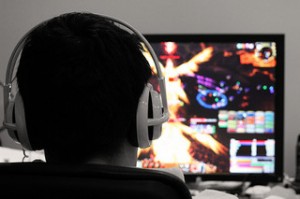What We Don’t Know, and What We Need to Know, About the Effects of Video Game Violence
January 18, 2013
Every parent and concerned citizen in the U.S. has been following the national conversation about the need for an urgent and balanced response to the tragedy at Sandy Hook Elementary School in Newtown, Connecticut. One area of concern that the President and Vice President highlighted in the action plan they presented on this week is the role that media portrayals of violence may have on vulnerable children’s well-being. Our leaders will urge the Centers for Disease Control and Prevention to study the relationship between media portrayals of violence and possible effects on public health outcomes.
While there is no demonstrated link between video game play and violence of the kind we have seen all too often in recent years, there is an active scientific debate over what we know and do not—and which next steps the scientific community should take to more definitively understand the dynamics of the many factors that are associated with highly damaging anti-social behavior. To help unpack the debate, I asked Cheryl Olson, Sci.D., one of the nation’s leading authorities on the subject and author of Grand Theft Childhood to weigh in on the key research issues. Her perspective follows. In the coming days I will be sharing other research perspectives on our blog and in the Huffington Post.
— Michael H. Levine
What we don’t know, and what we need to know, about effects of video game violence
At Vice President Biden’s meeting last week with game industry representatives and researchers, he made two things crystal clear. First, the evidence he’d seen did not show that violent video games cause violent acts. Second, many members of the public think they do, and the game industry had better address that belief.
The research so far

Photo by Joel Emberson
To date, video game researchers have generated more heat than light. As the Vice President said, and the Supreme Court agreed, no studies have found a causal link between violent video games and real-life violence. The plain truth is that most video game violence studies are not designed to provide guidance to policymakers, practitioners or parents; they are designed to place publications in academic journals and advance careers. And there are so many other problems with existing research. To name a few:
- Studies often measure aggressive behavior, but there is no widely agreed-upon definition of “aggression” or its relationship to physical violence.
- Many lab studies use a test of competitiveness, call it a measure of aggression, and equate tiny differences in this measure with readiness to physically harm others.
- Non-lab studies typically have small, non-representative samples.
- Developmental differences are usually ignored; results from college students are freely generalized to young teens. We don’t know whether there are critical periods with greater potential for harm (or benefit).
- Data cited are often a decade or more out of date, ignoring the rapid changes in the sophistication and availability of games. For example, in some modern games, the plot shifts based on moral choices players make.
- It’s assumed that games with violent content all have similar influences. Applying this line of reasoning to books, the Bible and a Twilight novel would have identical effects on readers.
- The context of play is usually ignored. Twenty minutes of assigned game play in a lab is assumed to represent children playing games they choose, in familiar environments, based on their current social or emotional needs—often for hours at a time and across many years. Group game play, which is typical for teens, is virtually unstudied.
When I began my research at Harvard in 2004, we had barely started to address the basics: who plays what games, how much and how often, with whom, and why. My research tried to answer these questions for 7th and 8th graders attending public schools, and how these factors might relate to common problem behaviors such as bullying and fighting. (Briefly, we found a correlation between violent games and some bad behaviors, but the link vanished when we factored in aggressive personality and stressful life events. Chris Ferguson at Texas A&M International University kindly continued these analyses after our grant funding ran out.) Since then, the MacArthur Foundation, Robert Wood Johnson Foundation, the Pew Research Center and others have funded exciting work on children and video games—but avoid the political minefield of violent content.
The most pressing research priorities
We need to address the shortcomings noted above. But there are also subgroups of high-risk youth that deserve attention. If our main concern is that violent video games could encourage or trigger the damaging of people or property, we ought to study the media use of juvenile offenders—young people who have actually tried to damage people or property—to see whether and how their media diet differs. I worry about teens exposed to real-life violence, living in dangerous neighborhoods without access to a healthy variety of activities, who may overuse violent games to cope with boredom, stress and anger. (It’s possible that to a point, violent games might be a safety valve; excessive use might echo and magnify the violence around them.) Children with mental health problems and developmental delays are also unstudied. Media coverage has linked mental illness and school shootings, however unreasonably. Studying the media use of this subgroup might aid our understanding of (or rule out) risk factors for violent acts, and show anxious parents ways to minimize any harms.
Advice to policymakers and industry
Last year’s Supreme Court ruling ended a string of attempts to outlaw various types of game violence or require new labeling. This week, the President called on Congress to “fund research into the effects that violent video games have on young minds.” I hope to see studies designed to inform policy, that will look at potential benefits of games (yes, even violent ones) as well as potential harms. Ironically, the parents most concerned about video game effects are the ones least likely to be affected; their children have involved parents who monitor and regulate their media use. To win hearts and minds, and limit legal and PR kerfuffles, industry would do well to co-sponsor research for a wide-ranging parent education campaign. To start, what do parents currently know, feel and do about games, parental control options, and even healthy child development? A 10-year-old who can’t tear himself away from a game to come to supper is not “addicted”; he’s normal.
 Cheryl K. Olson, Sc.D., was principal investigator for a two-year, $1.5 million Harvard research project to study the effects of video games on young teens, funded by the U.S. Office of Juvenile Justice and Delinquency Prevention. She coauthored a popular book based on that research, called Grand Theft Childhood: The Surprising Truth About Violent Video Games and What Parents Can Do. Her videos for parents on wise use of videogames can be found at: http://www.youtube.com/ckolsonscd
Cheryl K. Olson, Sc.D., was principal investigator for a two-year, $1.5 million Harvard research project to study the effects of video games on young teens, funded by the U.S. Office of Juvenile Justice and Delinquency Prevention. She coauthored a popular book based on that research, called Grand Theft Childhood: The Surprising Truth About Violent Video Games and What Parents Can Do. Her videos for parents on wise use of videogames can be found at: http://www.youtube.com/ckolsonscd



